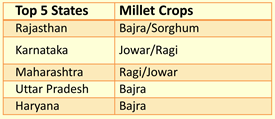

Context
ASSOCHAM organized a “National Conference on Millets: The Future Super Food for India” recently.
What are Millets?
|
In India, millets have been mentioned in some of the oldest Yajurveda texts, thus indicating that millet consumption was very common, pre-dating to the Indian Bronze Age (4,500BC). |
- Millets are a group of highly variable small-seeded grasses, widely grown around the world as cereal crops or grains for human food and as fodder.
- It is grown in 131 countries. Millets traditional food for 59 crore people in Asia & Africa.
- Millets are a rich source of protein, fibre, minerals, iron, calcium and have a low glycemic index.
- They are grown as grain crops, primarily on marginal land in dry areas of temperate, sub-tropical and tropical regions.
Background
Millets production in India
- Millets are grown in about 21 states in the country including Karnataka, Andhra Pradesh, Tamil Nadu, Kerala, Telangana, Uttarakhand, Jharkhand, Madhya Pradesh, and Haryana.
- India is now the 5th largest exporter of millets globally.
- Nearly 41% of total global production was met by India in 2020. In 2020-21, it exported millets worth US $26.97 million.


- Nearly 41% of total global production was met by India in 2020. In 2020-21, it exported millets worth US $26.97 million.
Importance
- Resistance: Due to its high resistance against harsh conditions, millets are sustainable to the environment, to the farmer growing it, and provide cheap and high nutrient options for all.
- Fibrous: Millet is fibrous in content, has magnesium, Niacin (Vitamin B3), is gluten-free and has highprotein content.
- Anti-diabetes quality: Millets can also help tackle health challenges such as obesity, diabetes and lifestyle problems as they are gluten free, have a low glycemic index and are high in dietary fibre and antioxidants.
- Millet ingestion helps in a slower release of glucose over a longer period of time; thus, due to low glycaemic index (GI), their habitual intake reduces the risk of diabetes mellitus.
- More sustainable: Besides, millets help in reducing the atmospheric CO2 and thus contribute in mitigating the climate change.
Steps taken for promoting millets since 2018:
- National Year for Millets 2018
- “Sub Mission on Millets” under National Food Security Mission since 2018.
- Several State launched mission on Millets.
- Millets included under POSHAN MISSION Abhiyan by Ministry of Women & Child Development.
- ICAR released one variety Quinoa (Him Shakti).
- Quinoa – A new crop: ICAR has been referred to suggest for declaring Nutri-cereals.
- 200 Start-ups supported through IIMR, Hyderabad.
- 67 Value added Technologies developed at Centre of Excellences.
- Export of Millets increased from $ 24 million (2017) to $ 26 million (2020).
- Release of 13 High Yielding varieties including 4 bio-fortified varieties of millets.
|
International Year of Millets (IYoM)-2023:
|



